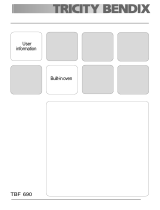
13
BEFORE USING THE OVEN
•
To make the most of your new oven, read the user
instructions and the Product Description Sheet
carefully and keep them safe for future consultation.
•
Remove the cardboard and polystyrene protection
pieces from the oven cavity.
•
Clean the oven cavity with non-abrasive detergent and
warm water.
•
Remove the accessories from the oven and heat it at
the maximum temperature for approximately 30
minutes to eliminate the smell of the protective grease
and insulating materials.
•
Keep the window open during this operation.
SAFEGUARDING THE ENVIRONMENT
1. Packaging
•
The packaging material is entirely recyclable, and
marked with the recycling symbol .
2. Oven
•
This appliance is marked according to the European
Directive 2002/96/EC, Waste Electrical and Electronic
Equipment (WEEE).
By ensuring that this appliance is scrapped suitably,
you can help prevent potentially damaging
consequences for the environment and health.
The symbol on the appliance, or on the
accompanying documentation, indicates that this product
must not be treated as household waste, but must be
delivered to the nearest collection centre for the
recycling of electrical and electronic appliances.
Disposal must be carried out in accordance with local
environmental regulations for waste disposal.
For further information on the treatment, recovery and
recycling of this appliance, contact your competent local
authority, the collection service for household waste or
the shop where you purchased the appliance.
PRECAUTIONS AND GENERAL
RECOMMENDATIONS
•
Always disconnect the oven from the power supply
before any maintenance operations.
• Do not allow children or infirm persons to
operate the oven without supervision.
•Make sure children do not play with the
appliance.
• The accessible parts of the oven may become
very hot during use. Keep children at a safe
distance.
• Never use abrasive materials or substances to
clean the GLASS since they may damage it.
• The appliance becomes very hot during use.
Do not touch the heating elements in the oven.
•
Any repairs or adjustments to the oven must be
carried out exclusively by a qualified electrician.
•
Make sure that the electrical cables of other appliances
used near the cooktop or oven do not touch hot parts
and are not trapped in the oven door.
•
Use oven gloves to remove pans and accessories when
the oven is hot.
• Do not cover the bottom of the oven with
aluminium foil.
•
Do not place flammable materials in the oven.
A fire may break out if the oven is inadvertently
switched on.
•
Do not place heavy objects on the door because they
could damage the oven cavity and hinges. Maximum
weight: 7 kg (15lbs).
•
Never lean or sit on the oven door when it is open.
Never hang anything heavy on the door handle of the
oven when it is open.
•
This appliance must be used exclusively for the
purpose for which it was designed and built, namely
for cooking food. Any other use (such as heating
rooms) is to be considered improper and
consequently dangerous.
The manufacturer declines all liability for any damage
or injury deriving from improper or incorrect use of
the appliance.
A number of very important rules must be observed
when using any electrical appliance. In particular,
during use:
- do not pull the power supply cable in order to
unplug the appliance;
- do not touch the appliance with wet or damp feet;
- do not operate the appliance when barefoot.







